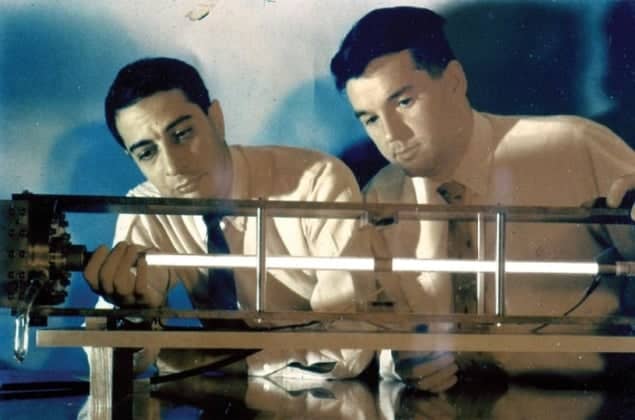The Idea Factory: Bell Labs and the Great Age of American Innovation
Jon Gertner
2012 Penguin Press £18.71/$29.95hb 432pp

Bell Labs was a legendary place, an industrial lab in the outer suburbs of New York where thousands of scientists, working nine to five, changed the world’s technological history. Their inventions included the transistor, cellular communication networks and the theory of information, but amazingly, these were only a few of the major contributions to applied science and engineering that occurred in this set of famously close-packed labs. Year after year, Bell Labs scientists refined existing products and developed entirely new technologies. Those of us who spend time programming are familiar with Bell Labs as the home of C, Unix and the statistical package S (forerunner of the current open-source standard, R). And perhaps the most celebrated Bell Labs achievement in pure science was the 1963 discovery of cosmic microwave background radiation by Arno Penzias and Robert Wilson.
Coming up with the occasional breakthrough is one thing, but reliably producing innovation – that’s something special. It gets even cooler when you realize that so much was done at Bell Labs, and for so long, that the aforementioned discovery of Big Bang radiation – along with C, Unix, S and various fundamental, Nobel-prize-winning contributions to physics – go unmentioned in a new history of the labs called The Idea Factory. I say this not at all as a criticism of its author, the journalist Jon Gertner; rather, there was just so much going on at Bell that it cannot all fit in one volume.
Perhaps the most impressive part of the Bell Labs story is the workaday nature of its successes. Apart from Claude Shannon, inventor of information theory, the labs had no transcendent geniuses. True, William Shockley was a notable figure and, sure, John Bardeen is the only person to have received two Nobel prizes in physics. But they were not legendary minds on the scale of Fermi, Feynman or Von Neumann. Hence the fascination of Bell Labs as an idea factory where the institution gets as much credit as the scientists for the discoveries they made.
So what made Bell Labs special? To start with, it was well run, with managers who typically had strong technical track records of their own, appreciated scientific work and paid their staff enough to live comfortably – but not so much that they could just take their millions and quit. And as Gertner shows, Bell did benefit from some special circumstances. Monopoly profits meant the company could afford to hire top scientists and engineers, and with university jobs not paying very well and few get-rich-quick opportunities such as we have seen in Silicon Valley in recent years, the high pay and excellent working conditions at Bell Labs attracted many who might look elsewhere today.
Second, there was nothing to do at the labs all day but work. I have known lots of middle-aged professors who don’t spend much time teaching but don’t do any research either. At Bell Labs it was harder to be deadwood. Located as it was in the middle of nowhere, the Murray Hill campus was not a place to relax, and if you were going into the lab every weekday anyhow, you might as well work – there was nothing better to do. Several researchers, including Shannon and Shockley, had sharp mid-career productivity declines – but after they left Murray Hill.
In my own experience working at Bell Labs for three summers during the 1980s, I vividly recall a general feeling of comfort and well-being, along with the low-level intensity that comes from working eight-hour days, week after week after week. I did the research underlying my most-cited paper while working in complete freedom for six weeks at Bell Labs during the summer after completing my PhD. So maybe being stuck in the lab until 5 p.m. every day isn’t such a bad thing – though it might be impossible to replicate this sort of distraction-free workplace in the Internet era.
In its heyday from the 1940s to the 1970s, a Bell Labs job was said to be just like working at a research university, except the pay was better, the equipment was more up-to-date, the machine shop was available for all your needs and you didn’t have to spend time teaching or applying for research grants. At a university, research grants can be distorting – and mediocre researchers who happen to be good at getting them can stay on and on and on. At Bell, the financial motive was not grants but contributing to the company’s product lines. This seems reasonable to me, both because telephone service is a public good and because, as Gertner notes, the challenges of improving phone service motivated technical advances that benefited other areas as well. Although not mentioned in the book, Penzias and Wilson’s discovery is a good example, since it came as part of an effort to get cleaner telephone signals. There is, however, an irony here: as Gertner points out, Bell Labs scientists spent decades scrubbing the noise out of local and long-distance telephone calls, but the modern era of cell phones reveals that most customers prize convenience and connectivity ahead of sound quality.
In his concluding chapter, Gertner gives what I see as his book’s overriding message. “It is now received wisdom that innovation and competitiveness are closely linked,” he writes. “But Bell Labs’ history demonstrates that the truth is actually far more complicated…creative environments that foster a rich exchange of ideas are far more important in eliciting new insights than are the forces of competition.” Although competition has been “superb” at bringing “incremental and appealing improvements”, Gertner argues, “that does not mean it has been good at prompting huge advances (such as those at Bell Labs, as well as those that allowed for the creation of the Internet, for instance, or even earlier, antibiotics)”. This all sounds reasonable.
Gertner concludes that modern corporate labs do not allow the same combination of freedom and long-term thinking associated with Bell’s glory days. But perhaps, rather than asking where the next Bell Labs will come from, we as a society should be looking to create and support the next Massachusetts Institute of Technology. Gertner includes a tantalizing story of a proposal in the 1960s to create “Summit University,” a research institute in New Jersey that would have been closely connected to Bell and several other nearby industrial labs. The project was not carried out because the estimated $16m cost was deemed too high. In retrospect that decision seems unfortunate.



